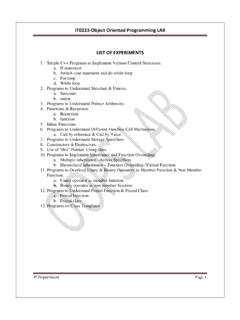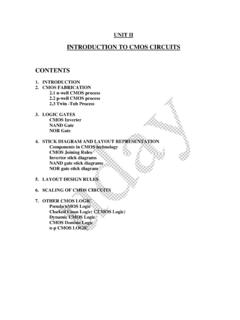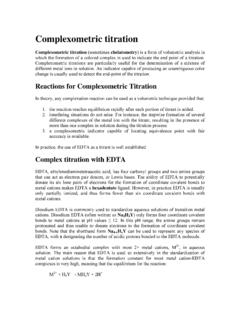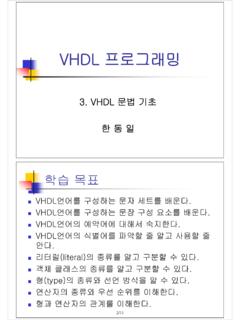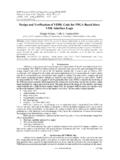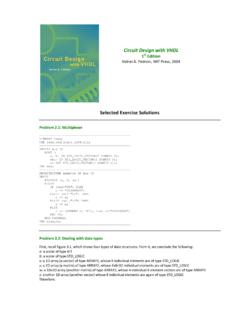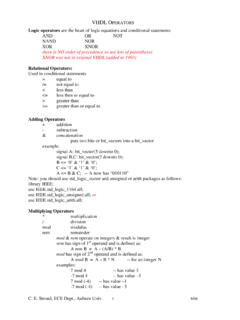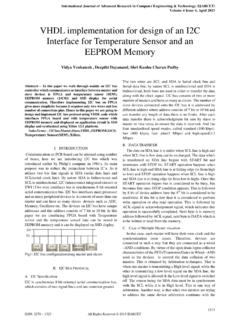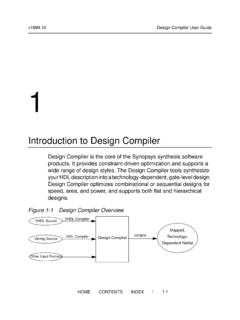Transcription of An Introduction to VHDL
1 UNIT V PRINCIPLES OF HDL CONTENTS 1. Introduction to vhdl vhdl Application 2. vhdl Program Structure Entity Block Architecture Block 3. vhdl Operators 4. Packages Package Declaration Package Body Important Packages 5. Data Types 6. Process 7. Sequential Statements Wait Statement Assertion Statement Report Statement Signal Assignment Statement Variable Assignment Statement Procedure Call Statement If Statement Case Statement Loop Statement Next Statement Exit Statement Return Statement Null Statement 8. Concurrent Statements Block Statement Generate Statement 9. Component Component declaration Component Instantiation and interconnections 10. Functions 11. Procedures 12. Simulation 13. Automated Testbench Generation Off-line configuration On-line configuration Adaptive configuration Testbench Example 14.
2 Introduction to Verilog 15. vhdl /Verilog Comparison Introduction to vhdl vhdl is an acronym for Very high speed integrated circuit ( vhsic ) hardware Description language which is a programming language that describes a logic circuit by function, data flow behavior, and/or structure. This hardware description is used to configure a programmable logic device (PLD), such as a field programmable gate array (FPGA), with a custom logic design. The general format of a vhdl program is built around the concept of BLOCKS which are the basic building units of a vhdl design. Within these design blocks a logic circuit of function can be easily described. A vhdl design begins with an ENTITY block that describes the interface for the design. The interface defines the input and output l1ogic signals of the circuit being designed. The ARCHITECTURE block describes the internal operation of the design.
3 Within these blocks are numerous other functional blocks used to build the design elements of the logic circuit being created. After the design is created, it can be simulated and synthesized to check its logical operation. SIMULATION is a bare bones type of test to see if the basic logic works according to design and concept. SYNTHESIS allows timing factors and other influences of actual field programmable gate array (FPGA) devices to effect the simulation thereby doing a more thorough type of check before the design is committed to the FPGA or similar device. vhdl Application vhdl is used mainly for the development of Application Specific Integrated Circuits (ASICs). Tools for the automatic transformation of vhdl code into a gate-level net list were developed already at an early point of time. This transformation is called synthesis and is an integral part of current design flows.
4 For the use with Field Programmable Gate Arrays (FPGAs) several problems exist. In the first step, Boolean equations are derived from the vhdl description, no matter, whether an ASIC or a FPGA is the target technology. But now, this Boolean code has to be partitioned into the configurable logic blocks (CLB) of the FPGA. This is more difficult than the mapping onto an ASIC library. Another big problem is the routing of the CLBs as the available resources for interconnections are the bottleneck of current FPGAs. While synthesis tools cope pretty well with complex designs, they obtain usually only suboptimal results. Therefore, vhdl is hardly used for the design of low complexity Programmable Logic Devices(PLDs). vhdl can be applied to model system behavior independently from the target technology. This is either useful to provide standard solutions, for micro controllers, error correction (de-)coders, etc, or behavioral models of microprocessors and RAM devices are used to simulate a new device in its target environment.
5 An ongoing field of research is the hardware /software co design. The most interesting question is which part of the system should be implemented in software and which part in hardware . The decisive constraints are the costs and the resulting performance. 2 vhdl Program Structure entity entity-name is [port(interface-signal-declaration);] end [entity] [entity-name]; architecture architecture-name of entity-name is [declarations] begin architecture body end [architecture] [architecture-name]; ENTITY BLOCK An entity block is the beginning building block of a vhdl design. Each design has only one entity block which describes the interface signals into and out of the design unit. The syntax for an entity declaration is: entity entity_name is port (signal_name,signal_name : mode type; signal_name,signal_name : mode type); end entity_name; An entity block starts with the reserve word entity followed by the entity_name.
6 Names and identifiers can contain letters, numbers, and the under score character, but must begin with an alpha character. Next is the reserved word is and then the port declarations. The indenting shown in the entity block syntax is used for documentation purposes only and is not required since vhdl is insensitive to white spaces. A single PORT declaration is used to declare the interface signals for the entity and to assign MODE and data TYPE to them. If more than one signal of the same type is declared, each identifier name is separated by a comma. Identifiers are followed by a colon (:), mode and data type selections. In general, there are five types of modes, but only three are frequently used. These three will be addressed here. They are in, out, and inout setting the signal flow direction for the ports as input, output, or bidirectional. Signal declarations of different mode or type are listed individually and separated by semicolons (;).
7 The last signal declaration in a port statement and the port statement itself are terminated by a semicolon on the outside of the port's closing parenthesis. The entity declaration is completed by using an end operator and the entity name. Optionally, you can also use an end entity statement. In vhdl , all statements are terminated by a semicolon. Here is an example of an entity declaration for a set/reset (SR) latch: entity latch is port (s,r : in std_logic; q,nq : out std_logic); end latch; The set/reset latch has input control bits s and r which are define d as single input bits and output bits q and nq. Notice that the declaration does not define the operation yet, just the interfacing input and output logic signals of the design. A design circuit's operation will be defined in the architecture block. We can define a literal constant to be used within an entity with the generic declaration, which is placed before the port declaration within the entity block.
8 Generic literals than can be used in port and other declarations. This makes it easier to modify or update designs. For instance if you declare a number of bit_vector bus signals, each eight bits in length, and at some future time you want to change them all to 16-bits, you would have to change each of the bit_vector range. However, by using a generic to define the range value, all you have to do is change the generic's value and the change will be reflected in each of the bit_vectors defined by that generic. The syntax to define a generic is: generic (name : type := value); The reserved word generic defines the declaration statement. This is followed by an identifier name for the generic and a colon. Next is the data type and a literal assignment value for the identifier. := is the assignment operator that allows a literal value to be assigned to the generic identifier name.
9 This operator is used for other assignment functions as we will see later. For example, here is the code to define a bus width size using a generic literal. entity my processor is generic (busWidth : integer := 7); Presently, busWidth has the literal value of 7. This makes the documentation more descriptive for a vector type in a port declaration: port( data_bus : in std_logic_vector (busWidth downto 0); q-out : out std_logic_vector (busWidth downto 0)); In this example, data_bus and q_out have a width of eight (8) bits ( 7 down to 0). When the design is updated to a larger bus size of sixteen (16) bits, the only change is to the literal assignment in the generic declaration from 7 to 15. ARCHITECTURE BLOCK The architecture block defines how the entity operates. This may be described in many ways, two of which are most prevalent: STRUCTURE and DATA FLOW or BEHAVIOR formats.
10 The BEHAVIOR approach describes the actual logic behavior of the circuit. This is generally in the form of a Boolean expression or process. The STRUCTURE approach defines how the entity is structured - what logic devices make up the circuit or design. The general syntax for the architecture block is: architecture arch_name of entity_name is declarations; begin statements defining operation; end arch_name; example, we will use the set/reset NOR latch of figure 1. In vhdl code listings, -- (double dash) indicates a comment line used for documentation and ignored by the compiler. library ieee; use ; -- entity block entity latch is -- interface signal declarations port (s,r : in std_logic; q,nq : out std_logic); end latch; -- architecture block architecture flipflop of latch is begin -- assignment statements q <= r nor nq; nq <= s nor q; end flipflop; The first two lines imports the IEEE standard logic library std_logic_1164 which contains predefined logic functions and data types such as std_logic and std_logic_vector.

